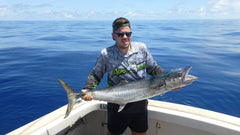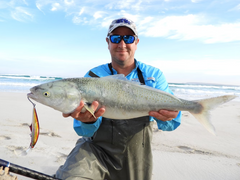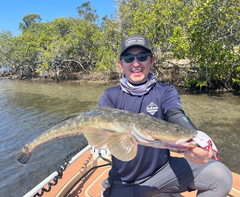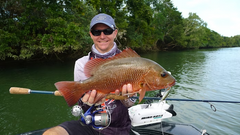Squid Fishing in Australia - A Guide for Anglers
Squid, or calamari as they are known, are one of the most readily available species for anglers around Australia, even if a lot of people don’t know it. It’s true that wherever you find yourself along our coastline, you can catch at least one of the several squid species we have here, and that includes Tassie!
Their availability makes them highly sought after, but they offer more than just that. Their willingness to eat large prey, forgiveness of sloppy presentation, alien appearance, and gourmet eating qualities make them worthy of more praise than they get.
These unsung heroes of the sea offer a unique and fun fishing experience for beginners and veterans alike, and what’s more, you don’t even need a boat to do it. If you’ve ever wanted to learn how to catch squid, chances are it’s going to be easier than you thought!
Squid Species
There are many species of squid worldwide, but the main three encountered by Aussie anglers are Big Fin Reef Squid (also known as Northern Calamari or Tiger Squid), Southern Reef Squid or Southern Calamari (Sepioteuthis australis), and Arrow Squid (Nototodarus gouldi).
Northern Squid tend to inhabit tropical and sub-tropical latitudes, while Southern and Arrow Squid are found in more temperate waters. There is overlap in these ranges, and Arrows are found from Exmouth all the way down and around to Cairns, with a few areas where all three can be taken in the same session.
All of these cephalopods have short lifespans of about one year, with Northern and Southern squid spawning over shallow reefs through spring and summer, and Arrows spawning at various times throughout the year in deeper water. Having a short life means they need to eat regularly to sustain a healthy growth rate, and because of this, they are almost always looking for food.

Squid Tackle
Squid tackle couldn’t be simpler, with any light spin gear perfectly suitable. Anything you’d feel comfortable using for bream, bass, flathead, and whiting will work just fine as a squid outfit.
If you can, you should arm yourself with squid-specific tackle. Known as ‘egi’ rods (egi is the Japanese word for squid jig), squidding rods are long and soft. It’s much easier to stay connected to a squid when using an egi rod, as stiffer actions are more likely to pull the prongs out of the squid’s tentacles.
There are many jigs from trusted brands that work really well all over the country. The Yamashita Egi-O Q Live, Daiwa Emeraldas Nude, Yozuri, IKA, and Shimano Sephia Cinch all have a proven track record, and each comes in a range of effective colors, weights, and sizes.

Squid Fishing Tips
Whether you’re fishing from a boat, a pier, or just off the shore, it’s a good idea to fish the clearest water you can find. Inshore areas are usually at their cleanest on high tide, making this a good time to go squidding, regardless of the time of day.
Structure is important for these animals as well, with rock, rubble, coral, weed, and mangroves providing great habitat for the small fish and crustaceans they eat. Squid are also food for larger predators and won’t stray too far from anything they can hide in.
When fishing from the shore, taking a few steps between each cast will help you to cover the water you need to find the squid. In a boat, anglers often use the wind to drift across likely ground and cover water this way.

Squid Tackle Tips
Bait fishing is also an option! Dead baits such as pilchards will attract squid, and rigging them on a barbed pin squid jag from companies like Neptune Tackle and suspending them under a float will put you in with a good chance. Squid aren’t usually able to pull the float down, and instead, you may notice the float bobbing or moving to the side slowly when there’s a cephalopod mouthing your bait.

Landing Squid
Landing these animals is where the fun really begins. Most cephalopods, including squid, have ink that they can shoot out of special ink sacs near the gills. Ink is discharged when the animal is distressed and works a lot like a smoke bomb for James Bond villains.
To avoid any inky disasters on you or in your boat, netting the squid is the best way to go. Scooping from the head end will make netting them easier. Trying to scoop their tentacles first will see them jetting off when they see the net, and you’ll risk losing them. Once netted, it’s a good idea to hold them over the water for a few seconds while they shoot out the last of their ink.

Now You Try
If you live near the coast and you’ve never been squid fishing, what are you waiting for? There’s a readily available source of gourmet food and highly entertaining fishing waiting right on your doorstep. If you’re interested in taking up the challenge, Tackle World can help kit you out and get you pointed in the right direction. Make sure you drop into your local Tackle World and get the lowdown on the local squid!
Article by Bob Thornton.


 Select Store
Select Store








